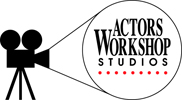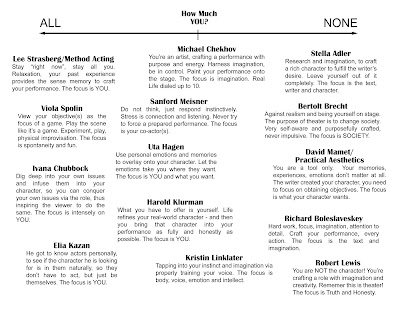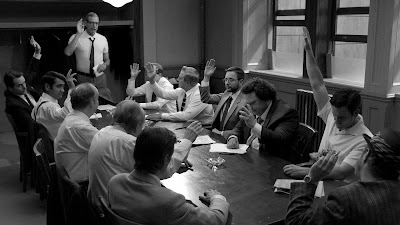Hello advanced ones!
So we ended August with a bang. Class was a whirlwind of activity, and it ended way too soon for my tastes…
We started with the Ceremonial Reading of the Coach’s Notes, which included a reference to the upcoming Agent Showcase (date to be determined), and what you can do to prepare for it, should you wish to try catching San Diego representation.
Remember: Sign up on the sign-up sheet posted next to the coach’s office!
You will ideally perform a comedic 2-person scene. Find a 3-minute scene and a partner to work with. If comedy isn’t your thing, go for a 2-person dramatic scene instead. I have tons of scenes and screenplays in my archives – if you need suggestions, let me know! If you’re a lone wolf, and would rather go at it alone, then a monologue of up to 90 seconds is allowed as well. Between now and the showcase, we will be allocating class time to work on these scenes.
This Was Us
After this, we queued up our This Is Us scenes and watched them. I loved this! You guys were awesome. As we watched each scene, we heaped on the praise and the constructive criticisms, and generally enjoyed the review time. So much fun – I wish we could film like this every week. But focusing on technique and craft study is important as well, so everything in balance and in its place.
If you’d like to watch the scenes again, scroll down to the next post (dated 8/22), and you’ll find them there.
The YOU Chart
After reviewing the This Is Us scenes, I passed out a “You Chart” that I whipped up for you all, which I will post here for reference (click to enlarge):
As you can see, across the top is a continuum, asking a question: How much YOU should you put into your performance? I also listed every acting technique I’ve been researching, and tried to summarize and encapsulate the boiled-down core philosophy of each – TO THE BEST OF MY CURRENT UNDERSTANDING – and placed them on the page underneath the appropriate region of the You Continuum.
For example: Method Acting is very highly focused on YOU and what is going on inside you as you perform, whereas Adler and Mamet, etc, don’t think YOU should be in the work at all. To them, you are a tool, used to make the audience feel something, without reference to what you may or may not be feeling. Again, I stress these summaries are based on my own research and understanding – I say that to avoid arguments with die-hard advocates of certain techniques, who may feel I misrepresented them in some way.
All methods have pluses and minuses – I highly recommend playing with them all, and pulling tools from each for your own tool bag. Some roles may be best served by you being your own unchanged day-to-day self! If so, don’t change a thing, just be you! Other roles may require you to be a stylized, modified version of you (while staying alive and YOU underneath it all). And still other roles may require crafting a complete, separate character, with YOU buried way down underneath.
You should train yourself to recognize which approach to take, and have tools to help you. That’s another (intended) benefit of the You Chart above – so as you grow and pursue training elsewhere, you’ll know which classes to look into taking. It’s similar to picking a church (if that’s your thing). You could pick a church at random, thinking “Well, church is church, right?” Or you could look into what different churches espouse and make an educated choice. You could pick an acting class at random (I’ve done that myself before), thinking “Well, acting is acting, right?” Or you could do a little research.
Side Note: You’ll notice Stanislavsky is conspicuous in his absence on my chart. Being a great experimenter in his approach, he dabbled in techniques and approaches and mindsets over his lifetime that would place him all over that continuum. Literally, every person named on that chart traces his/her lineage back to Stanislavsky, during one era of his career or another.
12 Angry Men
After discussing the You Chart for a brief time, we passed out a scene from 12 Angry Men (1957 dir. S. Lumet), and the accompanying character notes. You each picked sides at random, and then were told to take the character notes and infuse them into YOU for the scene work. After giving you some time to get familiar with the sides, we threw caution to the wind and started filming.
I brought my trusty Lumix, LED lights and my little H1 field recorder and we fired it all up and began. Honestly, I had a blast. But before I knew it, Jonny noted that the class was basically over – and we’d only gotten a page or so of the 5 page scene in the can! All due respect to Karen Carpenter, but we’d only just begun! I had to pull the plug on the shoot, but I’ll cut together what we did film, and salvage what I can. Perhaps some day we can fire it up again and re-shoot it, with more time. I would say pick up where we left off, but the odds that the same group of students would be there again are super-slim. We’d have to recast and shoot the whole thing in one night, probably from the outset of class.
Either way, it was a fun exercise, and you all seemed to be into it, so I hope you don’t feel that our failure to cross the finish line made the time wasted. I’m glad we gave it a shot.
I will post the results at the end of this post, once I finish cutting it. I will also post a monologue I shot with Julian a couple weeks back, which I’ve been working on, to show you what each of you could possible do in the future – a more cinematic, crafted approach to filming a monologue, beyond the traditional “one long take” single camera approach. Super fun, and the possibilities are limited only by our imaginations!
Next week, Yolanda Franklin will be taking over the class – I’m sure you’ll love what she has to offer. I’ll still be around and accessible.
Find your scenes and partners for the Agent Showcase! Let’s show them how it’s done!
Dave Wagner
AWS Staff



